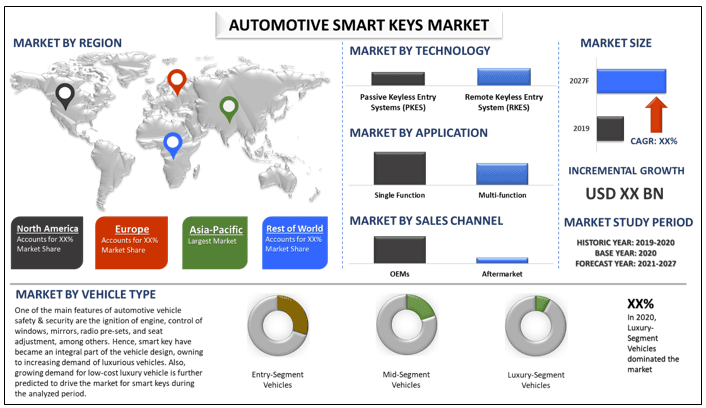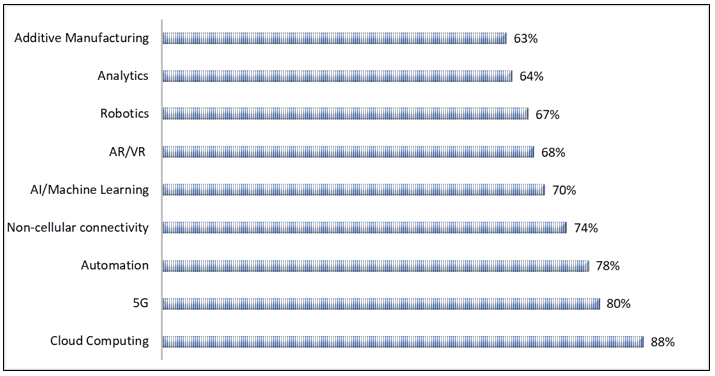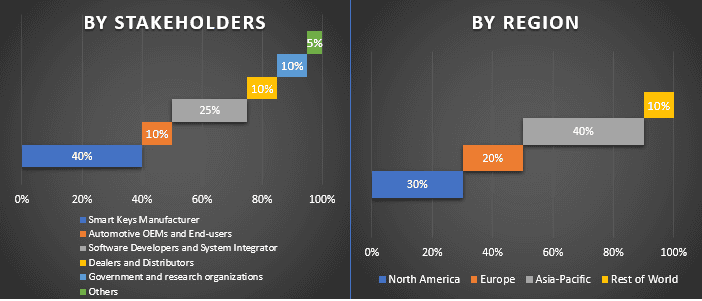
자동차 스마트 키는 2021-2027년 예측 기간 동안 8% 이상의 CAGR 성장을 보일 것으로 예상됩니다. 자동차 부문의 스마트 키는 보안상의 이점으로 인해 지난 수십 년 동안 인기를 얻었습니다. 자동차 OEM은 고급 럭셔리 자동차 부문에 구현된 것과 유사한 기능을 예산 자동차에 채택하고 있습니다. Honda와 같은 회사는 예산 차량 제품을 위한 스마트 키 개발에 투자하고 있습니다. 또한 무선 주파수 신호를 사용하여 디지털 정보로 변환하는 첨단 기술의 출현으로 자동차 부문에서 스마트 키 채택이 보편화되었으며, 이는 모든 종류의 차량에서 스마트 키 채택에 충분한 성장 기회를 제공할 것으로 예상됩니다. 더욱이 차량 절도 건수의 증가는 차량 보안을 위한 생체 인식 시스템에 대한 수요를 더욱 증가시킬 것으로 예상됩니다. 2018년 뉴질랜드는 인구 100,000명당 1,172건으로 전 세계에서 가장 높은 차량 절도율을 기록했습니다. 차량 절도율이 가장 높은 다른 국가로는 우루과이, 이탈리아, 미국이 있습니다.
자동차 디지털 전환을 위한 주요 기술, 2020(%)

보고서에 제시된 통찰력
“기술 중에서 수동 키리스 엔트리 시스템(PKES) 부문이 시장을 지배합니다.”
기술을 기준으로 자동차 스마트 키 시장은 수동 키리스 엔트리 시스템(PKES), 원격 키리스 엔트리 시스템(RKES)으로 분류됩니다. 현재 대부분의 스마트 키 기술은 수동 키리스 엔트리 기술을 기반으로 합니다.
“응용 분야 중 다기능 스마트 키가 2020년 시장을 지배합니다.”
응용 분야를 기준으로 자동차 스마트 키 시장은 단일 기능, 다기능으로 나뉩니다. 다기능 스마트 키가 시장을 지배하고 있지만, 자동차 부문의 기술 발전과 혁신적이고 향상된 차량 보안 시스템에 대한 수요 증가로 인해 단일 기능 스마트 키 부문의 채택이 촉진될 것으로 예상됩니다.
“차량 유형 중 고급 세그먼트 차량 부문이 시장을 지배합니다.”
차량 유형을 기준으로 자동차 스마트 키 시장은 엔트리 세그먼트 차량, 미드 세그먼트 차량, 고급 세그먼트 차량으로 나뉩니다. 현재 스마트 키는 주로 고급 세그먼트 차량에 장착되어 있습니다. 고급 안전 및 보안 기술이 장착된 고급 차량에 대한 수요 증가로 인해 다기능 스마트 키의 전체적인 채택이 증가하고 있습니다.
“판매 채널 중 OEM 부문이 시장을 지배합니다.”
판매 채널을 기준으로 자동차 스마트 키 시장은 OEM 및 애프터마켓으로 나뉩니다. OEM 부문이 2020년에 시장을 지배했습니다. 그러나 애프터마켓 부문은 예측 기간 동안 상당한 성장을 보일 것으로 예상됩니다. 차량 및 운전자의 안전 및 보안과 관련된 우려가 커짐에 따라 자동차 OEM은 차량에 고급 생체 인식 기술을 배포하고 있습니다.
“아시아 태평양은 예측 기간 동안 상당한 성장을 보일 것으로 예상됩니다.”
자동차 스마트 키 수요에 대한 더 나은 이해를 위해 시장은 북미(미국, 캐나다, 북미 나머지 지역); 유럽(독일, 영국, 프랑스, 이탈리아, 유럽 나머지 지역); 아시아 태평양(중국, 일본, 인도, 한국, 아시아 태평양 나머지 지역); 세계 나머지 지역을 포함한 주요 지역에 대해 분석됩니다. 아시아 태평양이 2020년에 시장을 지배했습니다. 자동차 스마트 키 시장은 차량 절도 건수 증가와 가처분 소득 증가로 인한 고급/프리미엄 자동차에 대한 수요 증가로 인해 아시아 태평양에서 상당한 성장을 보이고 있습니다. 시장에서 활동하는 주요 업체로는 Robert Bosch, Continental AG, Qualcomm Technologies, Inc., Hella KGaA Hueck & Co., Denso Corporation, Hyundai Mobis, ZF Friedrichshafen AG, Tokai Rika Co. Ltd, Visteon Corporation, ALPHA Corporation이 있습니다.
이 보고서를 구매해야 하는 이유:
- 이 연구에는 인증된 주요 업계 전문가가 검증한 시장 규모 및 예측 분석이 포함되어 있습니다.
- 이 보고서는 전체 산업 성과에 대한 간략한 개요를 제공합니다.
- 이 보고서는 주요 비즈니스 재무, 제품 포트폴리오, 확장 전략 및 최근 개발에 중점을 두고 주요 업계 동료에 대한 심층 분석을 다룹니다.
- 산업에서 널리 퍼져 있는 동인, 제약, 주요 추세 및 기회에 대한 자세한 조사
- 이 연구는 다양한 부문에 걸쳐 시장을 포괄적으로 다룹니다.
- 산업에 대한 심층적인 지역 수준 분석
맞춤화 옵션:
자동차 스마트 키 시장은 요구 사항 또는 기타 시장 부문에 따라 추가로 맞춤화할 수 있습니다. 이 외에도 UMI는 귀하가 고유한 비즈니스 요구 사항을 가지고 있을 수 있다는 점을 이해하므로 귀하의 요구 사항에 완전히 맞는 보고서를 얻으려면 언제든지 저희에게 연락하십시오.
목차
자동차 스마트 키의 과거 시장 분석, 현재 시장 추정, 미래 예측은 전 세계 자동차 스마트 키의 수요와 판매를 분석하고 창출하기 위해 수행된 세 가지 주요 단계였습니다. 과거 시장 수치를 수집하고 현재 시장 규모를 추정하기 위해 광범위한 2차 조사가 수행되었습니다. 둘째, 이러한 통찰력을 검증하기 위해 수많은 결과와 가정이 고려되었습니다. 또한 업계 가치 사슬 전반에 걸쳐 업계 전문가들과 광범위한 1차 인터뷰가 진행되었습니다. 1차 인터뷰를 통해 시장 수치를 가정하고 검증한 후, 전체 시장 규모를 예측하기 위해 상향식 접근 방식을 사용했습니다. 이후 시장 세분화 및 데이터 삼각 측량 방법을 채택하여 산업 관련 세그먼트 및 하위 세그먼트의 시장 규모를 추정하고 분석했습니다. 자세한 방법론은 아래에 설명되어 있습니다.
과거 시장 규모 분석
1단계: 2차 출처에 대한 심층 연구:
연례 보고서 및 재무 제표, 실적 발표, 보도 자료 등 회사 내부 자료와 저널, 뉴스 및 기사, 정부 간행물, 경쟁사 간행물, 부문 보고서, 타사 데이터베이스 및 기타 신뢰할 수 있는 간행물을 포함한 외부 출처를 통해 자동차 스마트 키의 과거 시장 규모를 확보하기 위해 자세한 2차 연구가 수행되었습니다.
2단계: 시장 세분화:
자동차 스마트 키의 과거 시장 규모를 확보한 후, 주요 지역의 다양한 세그먼트 및 하위 세그먼트에 대한 과거 시장 통찰력과 점유율을 수집하기 위해 자세한 2차 분석을 수행했습니다. 보고서에 포함된 주요 세그먼트는 기술, 애플리케이션, 차량 유형, 판매 채널입니다. 또한 글로벌 맥락에서 자동차 스마트 키의 전체 수요를 평가하기 위해 지역별 분석이 수행되었습니다.
3단계: 요인 분석:
다양한 세그먼트 및 하위 세그먼트의 과거 시장 규모를 확보한 후 현재 시장 규모를 추정하기 위해 자세한 요인 분석을 수행했습니다. 또한 차량 및 운전자의 안전 및 보안에 대한 수요 증가, 고급 차량 판매 증가, 자동차 부문의 기술 발전 등 종속 변수 및 독립 변수를 사용하여 요인 분석을 수행했습니다. 과거 추세와 시장 규모 및 점유율에 대한 연간 영향이 분석되었습니다. 수요 및 공급 측면 시나리오도 철저히 연구되었습니다.
현재 시장 규모 추정 및 예측
현재 시장 규모 측정: 위의 3단계에서 얻은 실행 가능한 통찰력을 바탕으로 현재 시장 규모, 시장의 주요 업체, 세그먼트 및 회사의 시장 점유율에 도달했습니다. 필요한 모든 백분율 분할 및 시장 세분화는 위에 언급된 2차 접근 방식을 사용하여 결정되었으며 1차 인터뷰를 통해 검증되었습니다.
추정 및 예측: 시장 추정 및 예측을 위해 이해 관계자가 사용할 수 있는 동인 및 추세, 제약 및 기회를 포함한 다양한 요인에 가중치가 할당되었습니다. 이러한 요인을 분석한 후, 관련 예측 기술, 즉 상향식 접근 방식을 적용하여 전 세계 주요 지역의 다양한 세그먼트 및 하위 세그먼트에 대한 2027년까지의 시장 예측에 도달했습니다. 시장 규모를 추정하기 위해 채택된 연구 방법론은 다음과 같습니다.
- 가치(US$) 측면에서 산업의 시장 규모와 전 세계 주요 지역에서 자동차 스마트 키의 수요
- 시장 세그먼트 및 하위 세그먼트의 모든 백분율 점유율, 분할 및 세분화
- 제공되는 제품 측면에서 자동차 스마트 키 시장의 주요 업체. 또한 빠르게 성장하는 시장에서 경쟁하기 위해 이러한 업체가 채택한 성장 전략.
시장 규모 및 점유율 검증
1차 연구: 주요 국가의 최고 경영진(CXO/VP, 영업 책임자, 마케팅 책임자, 운영 책임자, 지역 책임자, 국가 책임자 등)을 포함한 핵심 오피니언 리더(KOL)와 심층 인터뷰를 수행했습니다. 그런 다음 1차 연구 결과를 요약하고 통계 분석을 수행하여 명시된 가설을 입증했습니다. 1차 연구의 입력 내용은 2차 연구 결과와 통합되어 정보를 실행 가능한 통찰력으로 전환했습니다.
다양한 지역의 1차 참가자 분할

시장 엔지니어링
데이터 삼각 측량 기술을 사용하여 전체 시장 추정을 완료하고 자동차 스마트 키 시장의 각 세그먼트 및 하위 세그먼트의 정확한 통계 수치에 도달했습니다. 기술, 애플리케이션, 차량 유형, 판매 채널 및 지역 분야의 다양한 매개변수와 추세를 연구한 후 데이터를 여러 세그먼트 및 하위 세그먼트로 분할했습니다.
자동차 스마트 키 시장 조사의 주요 목표
자동차 스마트 키 시장의 현재 및 미래 시장 추세는 연구에서 정확히 지적됩니다. 투자자는 연구에서 수행된 질적 및 양적 분석에서 투자를 위한 재량에 대한 전략적 통찰력을 얻을 수 있습니다. 현재 및 미래 시장 추세는 지역 수준에서 시장의 전반적인 매력을 결정하여 산업 참가자가 미개척 시장을 활용하여 선점자 이점을 누릴 수 있는 플랫폼을 제공합니다. 연구의 다른 양적 목표는 다음과 같습니다.
- 가치(USD) 측면에서 자동차 스마트 키의 현재 및 예측 시장 규모를 분석합니다. 또한 산업의 다양한 세그먼트 및 하위 세그먼트의 현재 및 예측 시장 규모를 분석합니다.
- 연구의 세그먼트에는 기술, 애플리케이션, 차량 유형, 판매 채널 및 지역이 포함됩니다.
- 자동차 스마트 키 산업에 대한 규제 프레임워크에 대한 정의된 분석
- 다양한 중개자의 존재와 관련된 가치 사슬을 분석하고 산업과 관련된 고객 및 경쟁업체의 행동을 분석합니다.
- 보고서에서 분석된 주요 지역에는 북미(미국, 캐나다, 북미 나머지 지역); 유럽(독일, 영국, 프랑스, 이탈리아, 유럽 나머지 지역); 아시아 태평양(중국, 일본, 인도, 한국, 아시아 태평양 나머지 지역); 및 세계 나머지 지역이 포함됩니다. 빠르게 성장하는 시장에서 생존하기 위해 시장 참여자가 채택한 자동차 스마트 키 부문의 경쟁 환경 및 성장 전략을 정의하고 분석합니다.
- 산업에 대한 심층적인 지역 수준 분석
관련 보고서
이 상품을 구매한 고객님들도 함께 구매하신 상품










